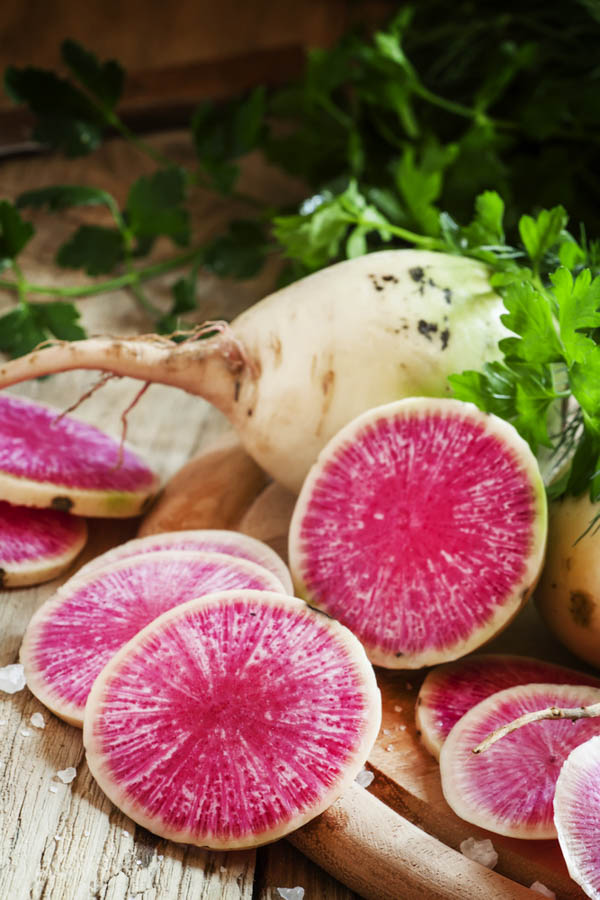Watermelon Radishes: Ideal Additions to a Holiday Platter

by C. Darren Butler and Ann Clary
GardenZeus earns commissions on sales made through links in this article. There is no additional cost to you.
Mantanghong radishes are the most popular of the Chinese radishes, growing up to 3 inches in diameter with a mild, sweet flavor in approximately 65 days. With light green exteriors and fuchsia interiors, Mantanghong, or watermelon, radishes make visually spectacular additions to a appetizer or vegetable platter. To purchase Mantanghong radish seeds click here.
Microclimate. Radishes will generally thrive in any cool, sunny area with reasonably loose and fertile soil. They will grow in part shade, but produce smaller roots and a smaller harvest over a longer period of time when not in full sun, and if they do not receive enough sun, may fail to form bulbed roots.
Soil Preparation. Double-dig or loosen new, compacted, or clay soils and remove stones and obstructions to at least 6 to 12 inches shortly before planting. Radishes prefer reasonably fertile, uniform, well-drained soil with sufficient potassium and moderate-to-high organic matter to a depth of at least 12 inches (deeper for larger and carrot-shaped varieties), but will tolerate difficult soils. Preferred soil pH for radishes is 6.5 to 7.0. They may tolerate significantly more acidity and slight alkalinity, but may not produce quality roots quickly under these soil conditions.
Planting. Seed radishes directly: plant a set of 2 seeds 5 inches apart. Radish seeds germinate best at temperatures between about 60° and 85° F, and produce the best-quality roots at temperatures between about 50° and 65° F.
Amending. Use caution with application of nitrogen. GardenZeus recommends adding nitrogen in the form of diluted urea or a cup of chicken manure diluted in 4 gallons of water (half cup if fresh manure) and mixed thoroughly, applied as a soil drench once when radish sprouts are 1 to 2 inches tall.
Mulching. Use a quarter-inch fine mulch for small starts when they reach 2 to 3 inches in height; increase to half-an-inch or more of fine-to-medium mulch after plants are at least 4 to 5 inches tall.
Watering. Radishes need uniformly moist but not wet soil to produce good-quality edible roots. Radishes generally require regular watering, especially in sandy or light soils. In clay and heavy soils, water slowly over time to encourage infiltration to the full depth of the radishes’ roots. Do not allow soil to dry between waterings. Overwatering or wet soil may result in poor root formation, shallow rooting, and/or rotting or diseased roots. Underwatering or soil dryness between waterings, especially during the first several weeks after germination, may result in poor root formation, split roots, bolting, and tough or pithy roots.
Radishes make excellent container plants. See Container Gardening With Lettuce, Radishes and Carrots.
Growing radishes are also an excellent way to improve your soil sustainably. See Sustainable Gardening: Growing Radishes to Improve Soil.
GardenZeus has customized growing information by plant and zip code. Don’t know your GardenZeus climate zone? Click here.
